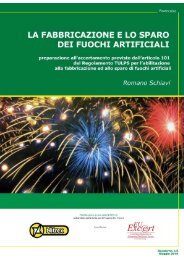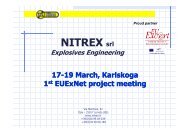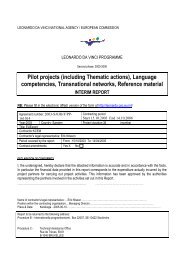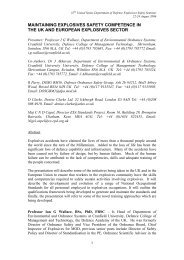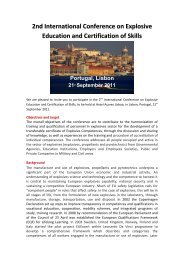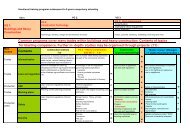SAFEX Newsletter No.35 - EU-Excert
SAFEX Newsletter No.35 - EU-Excert
SAFEX Newsletter No.35 - EU-Excert
Create successful ePaper yourself
Turn your PDF publications into a flip-book with our unique Google optimized e-Paper software.
<strong>SAFEX</strong> <strong>Newsletter</strong> <strong>No.35</strong>, 4 th Qtr. 2010 14<br />
Conclusion<br />
While this proposal is being debated careful attention<br />
should be given to the impact of proposed criteria, and<br />
to guard against the introduction of unintended<br />
consequences. Manufacturers may want to assess their<br />
inventory to see how classifications could be affected<br />
by criteria on metal fragments. We may wish to avoid<br />
impacts on 1.4 substances such as propellants. However<br />
if the only criteria added is for metal fragments this may<br />
not be a problem. Finally, we must avoid one thing that<br />
happened with the introduction of the 6(d) test where<br />
ICAO wrote their special provision to require the test<br />
regardless even if a competent authority judged it was<br />
not necessary. Competent authority expertise and<br />
discretion is the foundation of the UN classification<br />
methodology, as stated in the UN Manual of Tests &<br />
Criteria:<br />
“1.1.2 It should be noted that the Manual of Tests<br />
and Criteria is not a concise formulation of testing<br />
procedures that will unerringly lead to a proper<br />
classification of products. It therefore assumes<br />
competence on the part of the testing authority<br />
and leaves responsibility for classification with<br />
them. The competent authority has discretion to<br />
dispense with certain tests, to vary the details of<br />
tests, and to require additional tests when this is<br />
justified to obtain a reliable and realistic<br />
assessment of the hazard of a product. In some<br />
cases, a small scale screening procedure may be<br />
used to decide whether or not it is necessary to<br />
perform larger scale classification tests. Suitable<br />
examples of procedures are given in the<br />
introductions to some test series and in Appendix<br />
6.”<br />
If the 6(d) test is amended for this purpose, the new<br />
requirements would normally appear in the UN Model<br />
Recommendations in 2013 for adoption in regional,<br />
national and modal regulations in 2015.<br />
Explosives Eco-talk<br />
The impact explosives and explosives manufacture has on the Environment fall squarely in the <strong>SAFEX</strong> domain. We<br />
are as interested in the experiences members of the <strong>SAFEX</strong> community (Members, Associates and Expert Panel)<br />
have in minimising explosives’ environmental impact as we are in safety and health. While most of our explosives<br />
incidents concern the safety and health impact, we are eager to learn about the environmental side of our activities.<br />
By way of this Feature we want to encourage readers to let us have contributions which create awareness of this<br />
facet of our operations as well as assist our industry to behave with environmental sensitivity and responsibility.<br />
Recycling and Reuse of military explosives for the blasting industry<br />
Hans Wallin, Adviser KCEM www.kcem.se ;<br />
Prof. Bo Janzon, CEO, SECRAB, Sweden, www.secrab.eu<br />
The collapse of the Soviet Union<br />
in 1991 revealed enormous<br />
quantities of military material that<br />
was stored ready for use in<br />
magazines in the Soviet Union,<br />
USA and other countries. The<br />
existing recycling industry could<br />
easily take care of tanks, airplanes,<br />
guns and other non-explosive<br />
materials. Metals have been<br />
recycled for thousands of years but<br />
explosive wastes cannot be<br />
handled like ordinary wastes.<br />
Explosives constitute a very<br />
dangerous type of waste due to<br />
their ability to explode or detonate.<br />
In addition they are often toxic to<br />
both man and the environment. If<br />
not handled appropriately they can<br />
cause severe and fatal accidents.<br />
The purpose of this article is to<br />
give a general introduction to the<br />
challenges we face in disposing of<br />
redundant military explosives.<br />
The use of explosives started with<br />
black powder; an era which lasted<br />
1,500 years and left very minor<br />
environmental problems. The<br />
reason is simply that the<br />
ingredients ─ charcoal, nitrates<br />
and sulphur ─ easily lose their<br />
explosive properties when exposed<br />
to water. About 150 years ago high<br />
explosives (HE) were introduced<br />
starting with nitroglycerine, picric<br />
acid and trinitrotoluene (TNT).<br />
The last two explosive types were<br />
very stable in storage, had low<br />
sensitivity and quickly became<br />
very popular for military purposes.<br />
Modern military explosives are<br />
synthetic, have very stable<br />
properties and are often toxic.<br />
Therefore, they must be recycled,<br />
detonated, burned or chemically<br />
decomposed as they will normally<br />
not lose their explosive properties<br />
with time. Warheads, mines and<br />
other explosive articles when<br />
dispersed remain uncontrolled in<br />
the environment where they<br />
present a serious accident risk to



